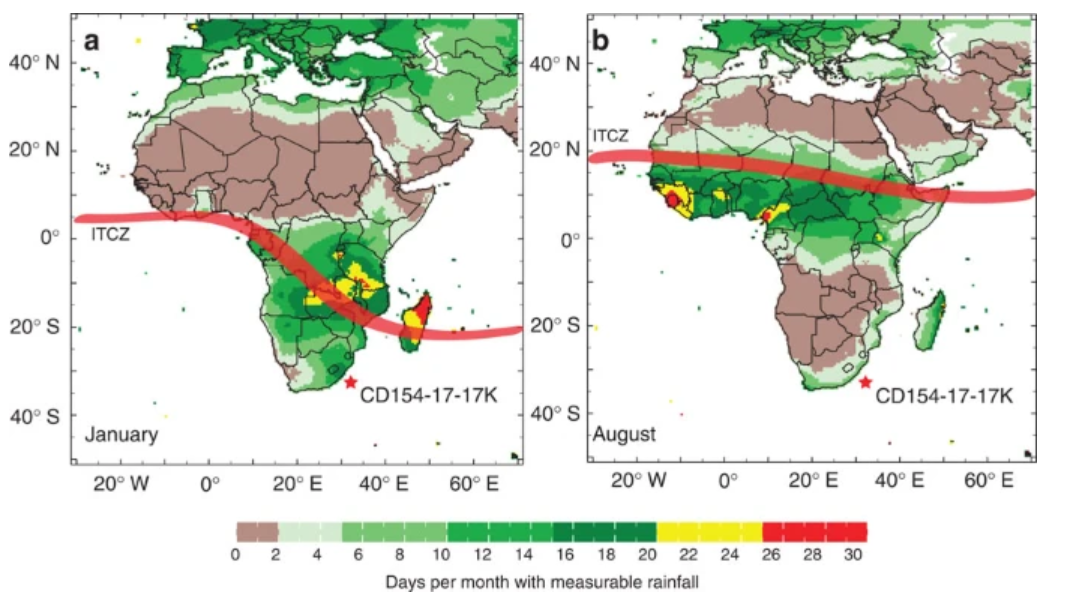It's Raining, It's Pouring...
Reflecting upon the mind map from my post on variability in Africa, I wish to delve deeper into precipitation in Africa in terms of current variability and projected changes. Exploring the physical dynamics and characteristics of water sources allows the our relationship with water and the challenges that are often encountered to be understood.
Rainfall in Africa appears to have a latitudinal symmetry, with the greatest rainfall occurring in Central Africa which reduces as you move both north and south of the equator. This spatial variation also occurs seasonally as well which has often been explained by the intertropical convergence zone (ITCZ) (Ziegler et al, 2013). The ITCZ forms at a region of low pressure near the equator where ascending Hadley cells meet resulting in rainfall in the tropics (Suzuki, 2011). The convergence of these trade winds happens seasonally, spreading over different areas at different times of the year (Barry, 2009). It must be noted that the ITCZ alone is not responsible for the seasonality and variability seen in rainfall; Nicholson (2017) mentions (while discussing East Africa) that further academic research is needed to gain a more in depth understanding of the dynamics at play. When considering rainfall and its variability in Africa, the El Nino Southern Oscillation (ENSO) and the Asian monsoon should also be taken into account (Camberlin and Philippon, 2002). In addition to these factors, precipitation can be influenced by topography, areas of higher elevation such as mountains often receive greater rainfall and are colder leading to less evaporation (UNEP, 2012). The difference in climates and biomes across Africa as discussed in the mind map also becomes clearer with a better understanding rainfall variability.
 |
| Rainfall variability across Africa in (a) January and (b) August with the ITCZ labelled in red Sourced from Ziegler et al, (2013) |
Anthropogenic climate change has already increased the variability of precipitation and it is likely to continue to do so in the coming years. Africa will be affected by climate change more than any other continent with a predicted increase of between 1.5-3°C by 2050 (Gemeda and Sima, 2015). As temperature rises, more water is evaporated which could lead to increased severe dry conditions (Hausfather,2018). A warmer climate will also impact the intensity of precipitation, the link between temperature and precipitation is defined by the Clausius-Clapeyron relationship which describes how more water vapour is held in the air when temperatures increase, 7% for every 1°C (Massam, 2020). Climate change will therefore lead to more intense precipitation as the air will have a higher moisture content which will then condense to produce heavier rains (Hausfather,2018). These changes will likely result in the increased occurrence of both floods and droughts. However, these conditions will not be felt evenly throughout the globe or within Africa, the effects of climate change will vary both spatially and temporally. For instance, models predict that southern Africa will experience a reduction in precipitation especially in the summer, and northern Africa will feel this reduction in the winter months; in contrast Central Africa is projected to have a higher occurrence of extreme precipitation (Hausfather,2018).
 |
| Projected changes in precipitation from 1981-2000 to 2081-2100 for each season Using multiple CMIP5 models under the scenario RCP8.5 Sourced from Hausfather (2018) |
Some populations in Africa are further made vulnerable to climate change due to the low income and development as well as the reliance on climate dependant sectors that can be found in a vast number of African nations (Gemeda and Sima, 2015). This results in difficulties when trying to mitigate, adapt and recover from frequent climate hazards (UNEP, 2017). Extreme events, such as flooding and droughts have several social and economic consequences. Droughts can lead to food insecurity especially when there is a heavy reliance on rainfed agriculture, therefore looking into alternatives such as the use of groundwater for irrigation is a key. Flooding can cause direct deaths, injuries as well as exposure to toxic substances and an increase in disease. In addition, environmental changes such as these add to water scarcity which already affects 1 in 3 people in Africa (WHO, 2020). Although precipitation is variable across the African continent it should also be considered that water scarcity is not being experienced solely due to the lack of water resources but rather due to uneven access to water in certain areas (UNEP, 2012).


Comments
Post a Comment